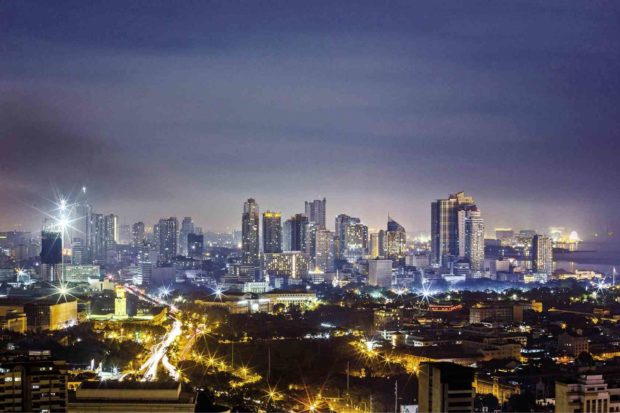‘Vaccine bubbles’ seen viable once Metro Manila hits inoculation goal

The Metro Manila skyline at night (File photo by JILSON SECKLER TIU / Philippine Daily Inquirer)
MANILA, Philippines — The proposal of economic managers to implement “vaccine bubbles,” or relaxing rules for vaccinated people, could work, but Metro Manila should first hit its inoculation target, Chairman Benhur Abalos of the Metropolitan Manila Development Authority said on Wednesday.
“It’s hard to set up certain policies when you have yet to reach your target. [Metro Manila mayors] hope it wouldn’t be discriminatory against unvaccinated individuals and should be a positive reinforcement,” Abalos said.
Under the modified enhanced community quarantine (MECQ), which is the current classification of Metro Manila, Abalos said that people could already go out except for certain activities, such as events in closed areas, meetings, and eating inside restaurants.
Trade chief’s proposal
On Saturday, Trade Secretary Ramon Lopez said he was pushing for the reopening of establishments that offered personal care and dine-in services in areas under MECQ only for vaccinated individuals.
“We have to study the details. But as far as its general policy is concerned, it looks like the mayors are open to this idea for the economy. It’s just that we have to really know the details [about the policy] first, because we don’t have enough details yet, including issues on security and implementation,” said Abalos, also the concurrent chair of the Metro Manila Council.
Article continues after this advertisementAbalos said that by October, Metro Manila cities might have fully vaccinated more than 70 percent of 9.8 million individuals who are eligible to receive a COVID-19 jab, which health experts consider as population immunity.
Article continues after this advertisementGranular lockdowns
As of Aug. 31, 81.72 percent of the eligible population in Metro Manila, or 8,009,042 individuals, had received their first jab, while 45.92 percent, or 4,500,510 individuals, had completed the recommended doses of the vaccines.
Aside from accelerating vaccinations, Abalos said Metro Manila mayors were banking on granular lockdowns instead of the usual two-week lockdowns that covered the entire region.
As of Wednesday, 3,342 areas—including 3,040 households, 7 barangays, and 129 streets — were under granular lockdowns.
“Our reproduction rate [in NCR] according to OCTA had dropped from 1.9 on Aug. 8-14 to 1.47 on Aug. 27, (then further to 1.43 on Aug. 31). The growth rate of cases, according to the DOH, dropped from 113.72 percent on Aug. 16 to 56.4 percent on Aug. 28. This means that while our cases are growing, the rate is not as high as before. So mayors shall continue with granular lockdowns to really isolate the cases,” Abalos said.